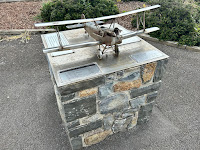 |
Patrick Hursey died when the wind was wild and from the East. In 1986 he took his boat out to rescue a lone, long-distance kayaker who was attempting to cross Bass Strait. As he tried to maneuver in close, a huge wave, in already mountainous seas, swamped the boat. Patrick was lost at sea, as was the kayaker. Only deckhand Phil Critchlow survived.
Stanley doesn't like it when the wind blows from the East.
We had a quiet morning. I tidied the finances and Sue went window shopping, although she was under strict instructions not to buy any. I joined her over coffee at Marleys, which has an elevated back deck looking over the town and across to Tatlows Beach in its long arc back to The Inlet. Coffee was good and we stayed until past the one o'clock closing time. Strange time to shut but I think its a siesta thing.
We walked back along The Terrace, our favourite street in Stanley, with its string of old houses, many of which date back to the 1890's and have all been fastidiously renovated. There are many holiday rentals among them. Towards the end of the row, Joe Lyons Cottage, managed by Tasmanian National Parks but manned by volunteers, sits in all its humility. It was the birthplace of the former Premier of Tasmania and Prime Minister of Australia. A tiny two or three bedroom dwelling, it has be restored lovingly and there is plenty of information about Lyons and his even more estimable wife, Dame Edith Lyons, the first female member of the House of Representatives. A remarkable lady. I particularly liked the picture of then Prime Minister Lyons, standing on the deck of the ship bringing him home to Australia, with a little, ringleted Shirley Temple holding his hand.
We were too close to Hurseys so had to have some hot chips for lunch while the seagulls surrounded us. We enjoyed the antics of the self-appointed boss seagull, who chased the others back into second receiver positions by a combination of head held high and wide beak screeching or stooping low and running at the others.
We didn't give them any.
 |
| A scale model of Arthur Long's D9 |
While there we discovered the story of Lieutenant Arthur Long, who in May 1919, took off from Stanley in a Boulton and Paul P9 and made the first successful crossing of Bass Strait by an aircraft. He landed at Torquay and then on to Fisherman's Bend in Melbourne. Interviewed after the flight, he said "I do not, for a moment, consider a daily air service is possible between Hobart and Melbourne." Brave, yes. Imaginative, no.
We wandered about out there, follow signs and our noses and got nowhere. "The Old Telegraph Station" turned out to be accommodation and we dead-ended at several other spots with signs of unwelcome on their gates.
.jpg) |
| Click here to see today's photos |
Moving on tomorrow to Burnie. This has been a very pleasant stay.
POSTSCRIPT
Despite the threat of rain, late in our day - 9:30 this evening - we went down to the National Parks viewing platform to see if could catch a glimpse of the Little Penguins coming ashore. Ten minutes in, the rain started and although it was only a bit heavier than a sprinkle, the driving wind gave it a potency even the rain had not intended. There must have been twenty people waiting but because of the way the platform is designed, there was plenty of viewing space. Essentially a raised platform at the end of a fifty metre walkway, all lit in discrete red which is part of the light spectrum penguins can't see. After about twenty minutes, the first penguin arrived and then another two and before long, twenty or so could be seen at the edges of the red light … and there they stayed for another fifteen or twenty minutes, preening and making small talk. The majority of the watches had taken their photos - respectfully under red light - and were starting to feel the rain inside their coats. The remaining five of us got to watch the rush made by the bigger group up past us, under the walkway and out of sight.
A final comment about the penguins’ perseverance. The area where they come ashore has no sand. It’s all bowling ball or bigger dolerite rock, broken in all sorts of angles and sizes. Yet these creatures of about 40cm height make their way across the rock field - there is no through - and then scramble up the grassy slopes to home. Quite remarkable.
No comments:
Post a Comment
All comments will be moderated before being posted.